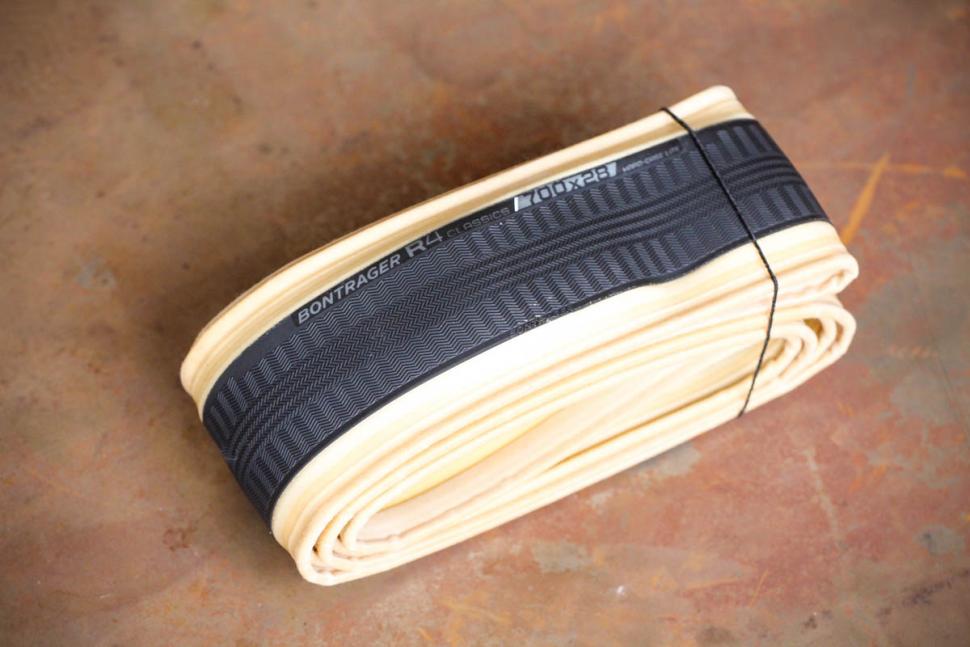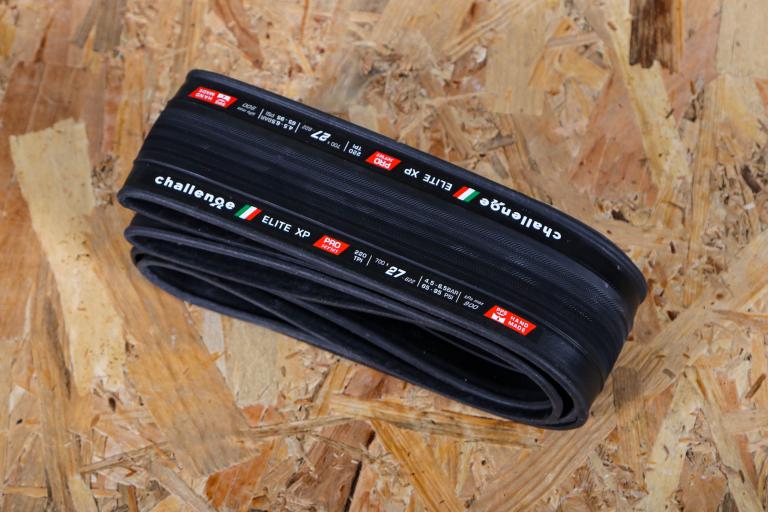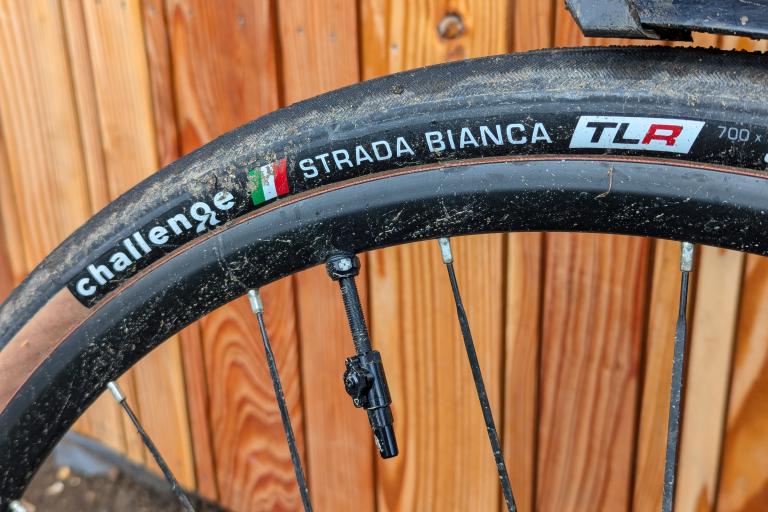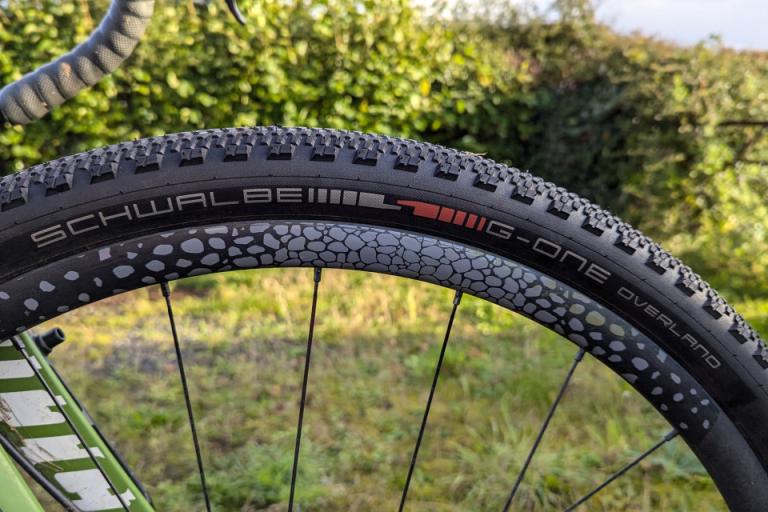- News
- Reviews
- Bikes
- Components
- Bar tape & grips
- Bottom brackets
- Brake & gear cables
- Brake & STI levers
- Brake pads & spares
- Brakes
- Cassettes & freewheels
- Chains
- Chainsets & chainrings
- Derailleurs - front
- Derailleurs - rear
- Forks
- Gear levers & shifters
- Groupsets
- Handlebars & extensions
- Headsets
- Hubs
- Inner tubes
- Pedals
- Quick releases & skewers
- Saddles
- Seatposts
- Stems
- Wheels
- Tyres
- Tubeless valves
- Accessories
- Accessories - misc
- Computer mounts
- Bags
- Bar ends
- Bike bags & cases
- Bottle cages
- Bottles
- Cameras
- Car racks
- Child seats
- Computers
- Glasses
- GPS units
- Helmets
- Lights - front
- Lights - rear
- Lights - sets
- Locks
- Mirrors
- Mudguards
- Racks
- Pumps & CO2 inflators
- Puncture kits
- Reflectives
- Smart watches
- Stands and racks
- Trailers
- Clothing
- Health, fitness and nutrition
- Tools and workshop
- Miscellaneous
- Buyers Guides
- Features
- Forum
- Recommends
- Podcast
review
£54.99
VERDICT:
Supple, fast and very pretty – expensive for some, worth it for me
Weight:
284g
Contact:
At road.cc every product is thoroughly tested for as long as it takes to get a proper insight into how well it works. Our reviewers are experienced cyclists that we trust to be objective. While we strive to ensure that opinions expressed are backed up by facts, reviews are by their nature an informed opinion, not a definitive verdict. We don't intentionally try to break anything (except locks) but we do try to look for weak points in any design. The overall score is not just an average of the other scores: it reflects both a product's function and value – with value determined by how a product compares with items of similar spec, quality, and price.
What the road.cc scores meanGood scores are more common than bad, because fortunately good products are more common than bad.
- Exceptional
- Excellent
- Very Good
- Good
- Quite good
- Average
- Not so good
- Poor
- Bad
- Appalling
Bontrager’s R4 Classics tyres are beautiful handmade clinchers that offer a smooth and very quick ride. You get great cornering grip and such a supple casing really helps on rougher roads.
- Pros: Very supple, look amazing, fast rolling
- Cons: Sidewalls will stain in proper 'Classics' conditions
Tyres are probably the best value for money component on your bike. Even a premium set like these won't break the bank, but they'll offer heaps of cornering confidence, extra puncture protection or even free speed.
> Find your nearest dealer here
These R4 Classics have, as the name suggests, been designed to tackle the road conditions commonly found in the spring races. They boast many of the features found in the tubular version that is used by Trek Segafredo for those very races. In fact, this is exactly the same tyre, with the only difference being that it isn't sewn around an inner tube!
In fact, the tyres are also very similar to the regular R4, with the difference here found in the file tread pattern used on the Classics rather than the slick rubber of the regular R4.
Installing the tyres is a little more involved than a standard clincher as these arrive completely flat. I picked up the trick of mounting without the inner tube and then leaving overnight. It works well and makes putting in the inner tube, especially a latex one, so much easier as you've got just enough shape to work with.
Once installed, the wide tread sits bang on 28mm on my Fulcrum Speed 40C wheels. They're not the widest rims, so I wouldn't be surprised to find these nudging 30mm on a wider rim.
Out on the road, these are simply beautiful to ride, with the supple casing and wide profile soaking up lots of road buzz. Throw these into a corner and the rounded profile results in loads of grip and zero skittishness.
The tyres have been really well made and spin perfectly straight when mounted. Handmade tyres like this can be a little wonky sometimes, so it's good to see none of that present with the R4 Classics.
Even though it's a larger tyre with a bit of a tread, this isn't a slow tyre. In fact, this would be a brilliant summer race tyre for larger riders and crit racers looking for maximum grip on tight city centre courses.
Bontrager has used its Hard-Case Lite puncture protection, but these are still a supple tyre, so try to avoid that broken glass.
> Buyer's Guide: 18 of the best tyres to keep you cycling through winter
I personally love the look of tan wall tyres on my bike but I would urge caution. These will stain with regular use in the rain. If left to go bad, they'll eventually develop rot in the casing, which can be very dangerous. That is, however, just the trade-off with tyres like this.
So, how do these stack up against similar options? Earlier in the year, I was testing Challenge's Strada Open Tubular (£54) which are very similar in construction. Both have a 320tpi casing, both get a file tread pattern and both cost about the same. The R4 Classics are a little heavier at 284g, but you're getting a 28mm tyre, 3mm wider than the Strada, which makes them perfect for larger riders on poor road surfaces.
If you're a fan of high-end tyres then you won't be disappointed with these. The R4 Classics are supple, roll well and give you great grip on dodgy corners: an excellent choice for larger riders or those wanting 28mm rubber.
Verdict
Supple, fast and very pretty – expensive for some, worth it for me
road.cc test report
Make and model: Bontrager R4 Classics Hard-Case Lite Road Tyre
Size tested: 700 x 28
Tell us what the product is for and who it's aimed at. What do the manufacturers say about it? How does that compare to your own feelings about it?
From Bontrager: "A fast-rolling road race tyre for when traction and confidence matter most. A high grip tread and compound performs in wet and dry conditions"
They roll really nicely and grip very well indeed.
Tell us some more about the technical aspects of the product?
From Bontrager:
Casing - 320 TPI casing
Compound - High grip tread and compound
Puncture Protection - Hard-Case Lite
Rate the product for quality of construction:
10/10
With handmade tyres, there can be slight wobbles in the line of the tread. These are perfectly straight when mounted up, showing top quality construction.
Rate the product for performance:
10/10
This is one of the best bigger road race tyres I've used. You get fast rolling speeds with brilliant comfort and excellent grip. That's exactly what having wider tyres on a race bike is all about.
Rate the product for durability:
7/10
They have lasted very well, especially the rear, which usually shows signs of wear. Use these in dry conditions and they'll easily last a full season. Run them in the rain too much without caring for them and you might find that they don't last so well...
Rate the product for weight (if applicable)
7/10
Weight is okay for a 28mm tyre like this. That said, it's not really the point of the tyre.
Rate the product for comfort (if applicable)
10/10
The wide profile and supple casing mean you can happily run these a little lower than usual and be very comfortable.
Rate the product for value:
6/10
They're expensive for sure, but for many people they will be worth the cash.
Tell us how the product performed overall when used for its designed purpose
Really well. Take these down a surface-dressed back lane and they're noticeably less jumpy than a standard tyre. These will be excellent for larger riders.
Tell us what you particularly liked about the product
The general feel of riding these tyres is brilliant. They're fast, grippy and comfortable on poor roads.
Tell us what you particularly disliked about the product
It's a shame that such a nice tyre can be spoiled by a few rainy rides. Probably best to save these for dry days. You could Aquaseal them or coat them in polyurethane, but only if you know you'll be using them repeatedly in the rain.
How does the price compare to that of similar products in the market, including ones recently tested on road.cc?
They're 99p more than the excellent Challenge Strada tyres that I tested earlier this year. Both do a fabulous job, but I'd suggest you go for the R4s if you're a bigger rider.
Did you enjoy using the product? Yes
Would you consider buying the product? As I'm not that big, I'd have the standard R4 in a 25mm version.
Would you recommend the product to a friend? Yes
Use this box to explain your overall score
I loved riding these tyres. They get points for being supple, well made, grippy and fast. I've dropped them half a mark as they're one of the most expensive clinchers around, and they won't stay fresh in poor weather.
About the tester
Age: 24
I usually ride: Cannondale Supersix Di2 My best bike is:
I've been riding for: 5-10 years I ride: Most days I would class myself as: Expert
I regularly do the following types of riding: road racing, time trialling, cyclo-cross, commuting, club rides, general fitness riding, I specialise in the Cafe Ride!
Latest Comments
- grOg 10 sec ago
Melatonin is a hormone; perhaps you meant melanin..
- Wheelywheelygood 3 hours 50 min ago
Anything a council does always costs far more than if an ordinary company did it . We do wonder it any of that money ends up in someone's pocket ....
- imajez 4 hours 19 min ago
Letting one's tyres down by a few PSI to get more comfort grip and speed won't sell more bikes though.
- eburtthebike 6 hours 32 min ago
"......disgruntled residents continuing their protests by chaining bicycles the trees,..."...
- Secret_squirrel 6 hours 39 min ago
All competing for a role in a group that has been accused of being involved in massive corruption in the past. Hmm.
- Cycle Happy 7 hours 11 min ago
I've found the Chilli-Tech rear camera /light combo to be very good. ...
- quiff 7 hours 43 min ago
I was intrigued as to what, if any, connection the term has to Mongolia. According to, ahem, Wikipedia, Down himself (namesake of the syndrome)...
- Davisian 8 hours 21 min ago
I don't know why this is in the news, the Merseyside area is peppered with crossings that work like this and have done for decades. Maybe we don't...
- stonojnr 8 hours 32 min ago
at Man Utd its more about managing the bags of wind who used to play the game but now endlessly criticise from the comfy pundit sofa, than anyone...
- wtjs 9 hours 36 min ago
The cyclist told road.cc that he has not reported the near miss to the City of London Police because “what’s the point? They’re not interested...







Add new comment
12 comments
I'm a bit underwhelmed with these. Swapped to them when I destroyed the sidewall of one of my Veloflex Master 25s and these just feel dead in comparison. Thinking maybe that once you get to 28mm to really benefit from the extra volume you need to run lower pressures, which means running tubeless to avoid pinch flats. Will perservere and see if they bed in. Look fantastic though, which is half the battle!
Continuing to be slightly underwhelmed. Three punctures in last three rides, caused by tiny shards of gravel. Looking at the year carefully I picked over 20 out of the front tyre alone. Might just be that the roads aren't getting swept due to the low traffic levels in lockdown but I've never had a tyre like it (and I was running Veloflex Masters before these). Have bitten the bullet, installed Conti tubes, and I'm going to add a few ml of Orange Seal to the tubes to see if that helps
And yet another puncture, once again tiny shard of grit. At least the natural rubber carcass makes it easy to spot where the casing has been pierced.
I can't believe that a Veloflex Master (which is basically a fag paper of tread stuck to a similar carcass) is more puncture-resistant but I'm going to put that to the test next week as I'm done with these.
Tent sealant on tan sidewalls for easier cleaning and less chance of rot.
what's your reasoning for only suggesting you use these 28mm tyres for bigger riders (one that you repeat a few times) and that lighter riders should use the 25mm Challenge over the 28mm R4, also that you'd personally use the 25mm variant of the R4, why?
On a 17C rim I would expect a proper 28mm tyre to be closer to 30mm, as we've seen over history a few pork pies with regards to tyre sizing are seemingly still prevalent in the industry and on a 13/14mm internal bead these would come up short. My Panaracer Evo A 28mm come out at 30mm on a pair of H+Son TB14s even at 75PSI, Continental 4KIIs 28mm have been measured at 31mm on a 17mm rim so suspect these tyres are actually underwidth compared to other 28mm tyres. Thus the weight of these narrower tyres are somewhat misleading
Also what tubes did you use and what pressures?
As a fairly new tyre one would expect the price to cme down from the RRP and in reality it's cheaper than some other high end clinchers such as the Conti 5K and no more expensive than say the Barlow Pass.
I've been a fan of wider tyres for a while, not just for larger riders. But the bigger guys that I race with have been the first to say that they genuinely feel a positive difference.
As a smaller rider of 62kg, I don't need the extra volume as much. The sizing comment I agree with fully. Tyre size is very much dependant on the rims used but if you can get the bike industry to agree on a standard rim with for stating road tyre width, you'd be doing well.
Tubes used were latex challenge tubes. Pressure dependant on the weather but as a rough rule, mid-high 60's in the dry. Dropping towards 50 in the wet.
Yea, hopefully like Vittoria's Corsa G, these will drop in price come the start of the season.
just curious, how do these stack up, grip wise in the wet, against a GP4000iis?
I'm looking for a grippy tyre to inspire confidence in naff weather over all other issues. any other grippy tyre to recommend?
These are pretty good but not the best. Conti's 4 Season is the best I've ridden in the wet. I'd say pressure makes the biggest difference though. Try dropping 10-15psi and see if that works before investing in new rubber.
From the review:
"These will stain with regular use in the rain. If left to go bad, they'll eventually develop rot in the casing, which can be very dangerous".
What does this mean? Can you interpret this into something that's technically explicit? ..... "Go bad; develop rot"?
How does one not "leave them to go bad"? Are you just saying, "Clean them of road grime, salt and so forth"? What is it in such road grime that makes them "go bad" or "rot" - by what chemical or biological action?
Have you had something similar that did this? Or did you inadvertently discover the syndrome about these particular tyres during your test?
Or is it just, "Something I heard/read"?
Cugel
The slight staining is caused by road grime and brake pad grime. This only occurs in the wet. It's pretty easy to clean with both proper bike cleaner (Muc-Off/Morgan Blue) or just washing up liquid.
The rot is worse. This is caused by water ingress into the cotton threads. It takes a while to happen on summer bike but it's a real issue on a CX bike if cleaning isn't done soon after a wet race. Storing them in the dry also helps.
Bad rot is something that I've experienced with a set of Dugast tubs. A bit of discolouration isn't an issue beyond the cosmetic annoyance. But should it get really bad, the sidewall can fail. That, however, is something that I've thankfully only read about.
'Fast' based on what testing?
Every folding tyre I've ever bought arrived just like the picture in this review, so not sure how putting these on is any more involved?
Afraid we can only base the 'fast' bit on personal perception and experience. Bicyclerollingresistance.com don't yet have data on these tyres.
As an open tubular design, the tyre arrives with no shape at all, where a normal vulcanised tyre will have a little shape. It doesn't seem like much, but it certainly influences how easy mounting the tyre is. It's not too bad though. I think I've got the technique nailed now.